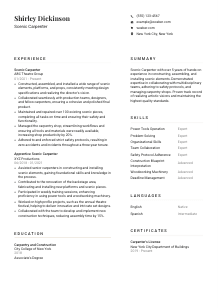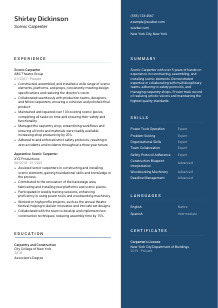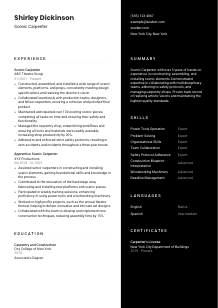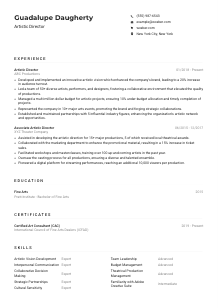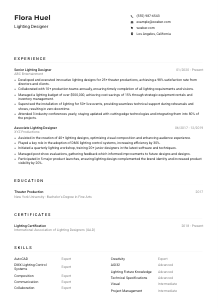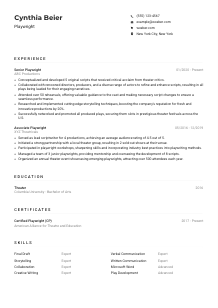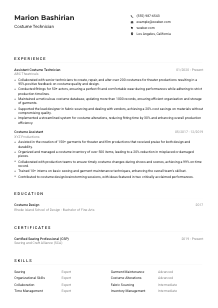Scenic Carpenter Resume Example
Building breathtaking sets, but feeling your resume lacks depth? Carve through this Scenic Carpenter resume example, sculpted with Wozber free resume builder. Discover how you can shape your scenic skills to align with job backdrops, making your career as striking as the scenes you craft!
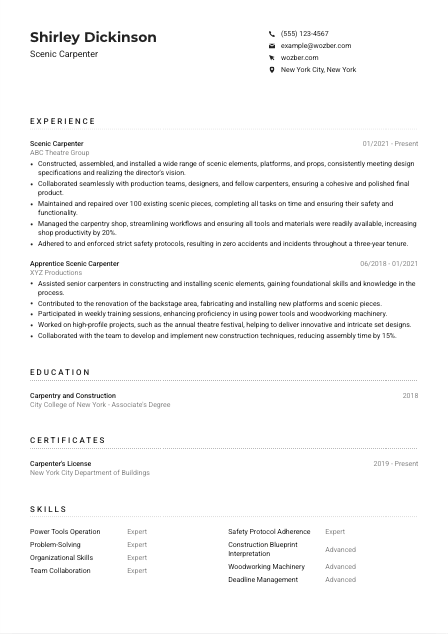
How to write a Scenic Carpenter resume?
Dive into the world of scenic carpentry, where every cut, plank, and nail serves not just a function, but tells a story on the stage. Are you ready to make your resume not just a document, but a testimony to your craft? Leveraging Wozber's free resume builder, including its ATS-compliant resume templates and ATS resume scanner for keyword optimization, this guide will walk you through creating a resume that brings your scenic carpentry skills to the forefront. With precision fitting a master carpenter, let's shape your resume into your best tool in landing your next Scenic Carpenter role.
Personal Details
Your resume's Personal Details section is your marque at curtain call, the first glimpse the director (read: hiring manager) has of you. Let's make sure it sets the stage compellingly, spotlighting you in the crowded audition that is the job market.
1. Spotlight Your Name
Think of your name as the title of your masterpiece – it should be visible and memorable. Opt for a clear, readable font, making it a touch more prominent than the rest of your text. This isn't just about aesthetics; it's about making sure your name leaves a lasting impression.
2. Title Yourself Appropriately
Below your name, echo the job title from the description. This alignment not only shows you're applying with intention but also helps in ATS optimization. For instance, stating "Scenic Carpenter" directly connects your application to the role at hand.
3. Ensure Accessible Contact Info
- Phone Number: This is your direct line. Ensure it's correct and keep your voicemail professional, anticipating that call back.
- Professional Email Address: Your email should be simple and professional. A combination of your first and last name is already a great start.
4. Highlight Your Locale
For this Scenic Carpenter role, right in the heart of New York City, mentioning your locale as "New York City, New York" instantly tells the hiring manager you're in the scene, ready to get to work without the hassle of relocating.
5. Professional Profile or Website
If you have a LinkedIn profile or a portfolio showcasing your past projects, include it. Ensure your online presence is polished and mirrors the craftsmanship in your resume.
Takeaway
The Personal Details section is where you set the stage. Make it count by being meticulous, professional, and aligned with the Scenic Carpenter role you're eyeing. This is your first impression. Make it as sharp and precise as your carpentry skills.





Experience
The heart of your resume lies in your experience. It's where you tell the story of your scenic carpentry journey, showcasing how each project, each role has been a step in mastering your craft. Let's build this section with the same precision you apply to your work.
- Constructed, assembled, and installed a wide range of scenic elements, platforms, and props, consistently meeting design specifications and realizing the director's vision.
- Collaborated seamlessly with production teams, designers, and fellow carpenters, ensuring a cohesive and polished final product.
- Maintained and repaired over 100 existing scenic pieces, completing all tasks on time and ensuring their safety and functionality.
- Managed the carpentry shop, streamlining workflows and ensuring all tools and materials were readily available, increasing shop productivity by 20%.
- Adhered to and enforced strict safety protocols, resulting in zero accidents and incidents throughout a three‑year tenure.
- Assisted senior carpenters in constructing and installing scenic elements, gaining foundational skills and knowledge in the process.
- Contributed to the renovation of the backstage area, fabricating and installing new platforms and scenic pieces.
- Participated in weekly training sessions, enhancing proficiency in using power tools and woodworking machinery.
- Worked on high‑profile projects, such as the annual theatre festival, helping to deliver innovative and intricate set designs.
- Collaborated with the team to develop and implement new construction techniques, reducing assembly time by 15%.
1. Align with Job Requirements
List each relevant job in reverse chronological order. For every role you've held, align your responsibilities and achievements with the requirements of the Scenic Carpenter position. This helps in ATS optimization and makes it easier for the hiring manager to envision you in the role.
2. Detail Your Roles and Achievements
For each position listed, detail your responsibilities, but more importantly, highlight your achievements. Using action verbs, explain how you "Constructed, assembled, and installed a wide range of scenic elements..." This tells a story of not just what you did, but how well you did it.
3. Quantify Your Impact
Wherever possible, quantify your achievements. Did your work increase productivity by 20%? Did you work on high-profile projects? Numbers help in providing concrete evidence of your capabilities and contributions.
4. Relevance is Key
Each point you make should directly relate to the Scenic Carpenter role. Perhaps you were part of a team that "Collaborated seamlessly with production teams, designers, and fellow carpenters..." Every line should aim to show why you're the perfect fit for the job.
5. Don't Forget Keywords
Specific phrases like "maintained and repaired over 100 existing scenic pieces" can be crucial in passing the ATS. Incorporate keywords from the job description naturally into your descriptions.
Takeaway
Your experience section is where you get to show off the craftsmanship of your career. By aligning it closely with the Scenic Carpenter role, using concrete numbers to quantify your achievements, and incorporating crucial keywords, you've crafted a portfolio of experience that speaks to your fit for the role as clearly as a well-made set speaks to an audience.
Education
Your education section may seem like a supporting role compared to your experience, but it lays the foundation for your skills. Let's ensure it complements the overall structure of your resume, reinforcing your qualifications for the Scenic Carpenter position.
1. Highlight Necessary Education
If the job requires specific educational qualifications, make sure those are front and center. Even though our job description didn't specify, mentioning your "Associate's Degree in Carpentry and Construction" shows you have a solid foundation.
2. Structure Simply
Keep this section clear. List your highest level of education first, followed by lesser qualifications. Include the degree, your field of study, the institution, and your graduation year.
3. Tailor to Fit
If you've taken courses or certifications that are directly relevant to scenic carpentry, this is the place to showcase them. It further aligns your resume with the Scenic Carpenter role you're applying for.
4. Display Relevant Achievements
Include academic achievements or extracurricular projects that demonstrate skills relevant to a Scenic Carpenter. Perhaps you've led a construction project or participated in a competitive woodworking event.
5. Keep it Updated
Even if you've been in the field for years, your education section can still lend credibility. Don't overlook recent courses or workshops that keep your skills sharp and up-to-date.
Takeaway
The Education section of your resume provides a solid base, illustrating your preparedness and dedication to the craft. By highlighting relevant achievements and ongoing learning, you demonstrate your commitment to excellence in scenic carpentry.
Certificates
In the world of scenic carpentry, certifications can be your golden ticket, showing your dedication to your craft and your eagerness to stay on top of your game. They validate your skills and can make you stand out in a sea of applicants.
1. Identify Essential Certificates
Go through the job posting carefully. If it mentions the need for a "Carpenter's License" or any relevant certification, place those at the top of your list. This aligns directly with what the role demands.
2. Quality Over Quantity
Don't flood this section with every certificate you've ever earned. Focus on those that are most relevant to scenic carpentry. This ensures the hiring manager sees your most applicable qualifications first.
3. Include Valid Dates
For certificates with expiration dates, such as your "Carpenter's License," make sure to include those dates. This confirms your qualifications are current and informs the employer of any upcoming renewals.
4. Pursue Continual Learning
Showcase your commitment to professional development by pursuing and mentioning up-to-date certifications. It speaks volumes about your dedication to maintaining a cutting edge in your field.
Takeaway
Your certificate section is more than a list; it's a testament to your commitment to excellence and professional growth. By carefully selecting and presenting your certifications, you underline your qualification and readiness for the Scenic Carpenter role.
Skills
Your Skills section is the toolbox of your resume. For a Scenic Carpenter, this means showcasing not just your ability to operate the tools of the trade, but also your capability to realize a design from blueprint to breathtaking set piece.
1. Match the Job's Needs
Scan the job description for skills and match them with your own. This shows the hiring manager at a glance that you possess exactly what they're looking for. For example, highlighting "Power Tools Operation" and "Construction Blueprint Interpretation" directly echoes the job's requirements.
2. Balance Hard and Soft Skills
While the tangible, hard skills like "Woodworking Machinery" operation are crucial, don't overlook soft skills. Your "Problem-Solving" and "Team Collaboration" abilities showcase your readiness to take on the dynamic environments of scenic construction.
3. Organized and Concise
Keep your skills section streamlined and relevant. Overloading it with every skill under the sun can dilute the impact of your key qualifications. Focus on the skills that make you a standout candidate for the Scenic Carpenter position.
Takeaway
The Skills section of your resume is a showcase of your professional and personal attributes that make you the right fit for the Scenic Carpenter role. Approach it as an opportunity to confidently present the unique blend of talents that only you bring to the table.
Languages
In the culturally rich industry of theater and scenic design, the ability to communicate in multiple languages can add an unexpected layer of value to your candidacy. Here's how to make your linguistic skills sing.
1. Hit the High Notes
Start with the languages specifically mentioned in the job description. For this role, "High level of fluency in English required" directly from the job post should take the center stage, marked as 'Native' or 'Fluent' depending on your proficiency.
2. Include Additional Languages
Even if not explicitly mentioned, including additional languages can enhance your resume, showcasing you as a diverse candidate ready to handle a multilingual environment.
3. Be Honest About Your Level
Clearly define your proficiency in each language. Misrepresenting your level can lead to uncomfortable situations, especially if the job demands it.
4. Understand the Scope
Consider the role's requirements. For a Scenic Carpenter, fluency in languages beyond English might not be critical, but it can still signal your ability to work in diverse cultural contexts, adding an extra layer of appeal to your application.
5. Languages Are Bridges
Remember, each language you know opens doors to new cultures and experiences, enriching your personal and professional life. They're not just skills; they're bridges to the world, making you a more versatile and appealing candidate.
Takeaway
Your linguistic skills, while perhaps not the star of the show for a Scenic Carpenter position, play a valuable supporting role. They signify a worldliness and adaptability that can set you apart in a field where understanding different cultures can inspire breathtaking sets.
Summary
Consider your Summary section the grand opening of your resume. It's your chance to captivate the audience (the hiring manager) from the outset, setting the tone for the rich narrative of skills, experience, and passion you bring to the role.
1. Set the Stage
Begin with a strong opening line, giving a nod to your years of experience and areas of expertise. For example, stating you're a "Scenic Carpenter with over 5 years of hands-on experience" immediately establishes your credibility.
2. Highlight Your Masterpieces
Point out key skills and achievements that align with the job description. Mentioning your "demonstrated expertise in collaborating with multidisciplinary teams" pulls directly from the job requirements, showing you're a perfect match.
3. Keep it Crisp
While it's tempting to include every accomplishment, the summary should be a teaser, not the full show. Keep it concise, aiming for no more than 3-5 powerful lines that invite the hiring manager to read on.
4. Make it Your Curtain Call
This is your chance to make an impression they won't forget. End your summary on a strong note, showcasing the unique blend of skills that make you an outstanding candidate for the Scenic Carpenter role.
Takeaway
Your Summary isn't just an introduction; it's your headline act, your spotlight moment. Craft it with care, making sure it showcases the very best of what you bring to the Scenic Carpenter position. A compelling summary sets the stage for a resume that demands attention, promising a performance (and a candidate) worth watching.
Launching Your Scenic Carpenter Journey
Well done! You've now got the blueprint to craft a Scenic Carpenter resume that resonates with precision, passion, and professionalism. By following this guide, leveraging Wozber's free resume builder, including the use of ATS-friendly resume templates and ATS resume scanner for keyword optimization, you're well-equipped to construct a resume that not only passes the ATS test but captivates the hiring managers. Your skill in scenic carpentry makes you a vital player in turning creative visions into reality.
Now, let your resume do the same for your career. The stage is set, the audience awaits. Break a leg!

- Minimum of 3 years of experience in scenic carpentry or a related field.
- Proficiency in using power tools, hand tools, and woodworking machinery.
- Strong understanding of construction blueprints, design specifications, and materials.
- Excellent problem-solving skills and ability to work well under pressure to meet deadlines.
- Possession of a valid Carpenter's License or relevant certification, if commonly required in job ads.
- High level of fluency in English required.
- Must be located in New York City, New York.
- Construct, assemble, and install scenic elements, platforms, and props according to design specifications and director's vision.
- Collaborate with production teams, designers, and other carpenters to ensure seamless integration of scenic elements.
- Maintain and repair existing scenic pieces, ensuring they are safe and functional.
- Manage and organize the carpentry shop, ensuring tools and materials are in proper working condition and readily available.
- Adhere to all safety protocols and regulations throughout the construction process.





